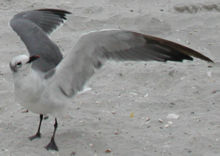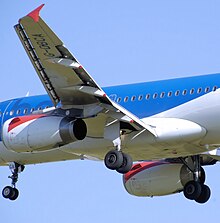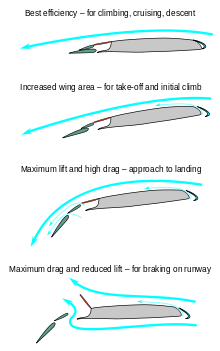User:Mr swordfish/Wing


A wing is a surface that produces lift for flight through the atmosphere—or occasionally through another gaseous or fluid substance. An artificial wing is called an airfoil, which always have a distinctive cross-sectional shape.
The word "wing" for many centuries (reportedly[by whom?]) referred mainly to the foremost limbs of birds, but in recent centuries the word's meaning has extended to include wings of insects, bats, pterosaurs, and aircraft.
"Wing" can also mean an inverted airfoil on a race car that generates a downward force to increase traction. Various species of penguins and their close relatives (such as auks) of flightless birds are avid swimmers, and use use their (rather small) wings to swim through seawater.
A wing's aerodynamic quality is expressed as its lift-to-drag ratio. The lift a wing generates at a given speed and angle of attack can be one to two orders of magnitude greater than the total drag on the wing. A high lift-to-drag ratio requires a significantly smaller thrust to propel the wings through the air at sufficient lift.
Design features[edit]
Aircraft wings may feature some of the following:
- A rounded leading edge cross-section
- A sharp trailing edge cross-section
- Leading-edge devices such as slats, slots, or extensions
- Trailing-edge devices such as flaps or flaperons (combination of flaps and ailerons)
- Ailerons (usually near the wingtips) to roll the aircraft clockwise or counterclockwise about its long axis
- Spoilers on the upper surface to disrupt the lift and to provide additional traction to an aircraft that has just landed but is still moving.
- Vortex generators to help prevent flow separation in transonic flow
- Wing fences to keep flow attached to the wing by stopping boundary layer separation from spreading
- Winglets to keep wingtip vortices from increasing drag and decreasing lift
- Dihedral, or a positive wing angle to the horizontal. This gives inherent stability in the roll direction. Anhedral, or a negative wing angle to the horizontal, has a destabilizing effect
- Folding wings allow more aircraft storage in the confined space of the hangar deck of an aircraft carrier
- Variable-sweep wing or "swing wings" that allow outstretched wings during low-speed flight (i.e., take-off and landing) and swept back wings for high-speed flight (including supersonic flight), such as in the F-111 Aardvark, the F-14 Tomcat, the Panavia Tornado, the MiG-23 the MiG-27, and the B-1B Lancer warplanes
The aerodynamics of wings[edit]
This section needs additional citations for verification. (May 2010) |


The design and analysis of the wings of aircraft (and of certain spaceplanes, such as the NASA Space Shuttle) is one of the principal applications of the science of aerodynamics. Aerodynamics is a branch of fluid mechanics, and the properties of the airflow around any moving object can - in principle - be found by solving the Navier-Stokes equations of fluid dynamics. However, except for simple geometries these equations are notoriously difficult to solve. Fortunately, simpler explanations can be described.
For a wing to produce "lift", its "leading edge" must be pointed at a correct angle (within a certain range) into the relative flow of air past the aircraft. When this occurs the wing deflects the airflow downwards, "turning" the air as it passes the wing. Since the wing exerts a force on the air to change it's direction, the air must exert a force on the wing, equal in size but opposite in direction. This force manifests itself as differing air pressures at different points on the surface of the wing.[1][2][4]
A region of lower-than-normal air pressure is generated over the top surface of the wing, with a higher pressure existing on the bottom of the wing. (See: airfoil) This higher pressure on the bottom of the wing is generally the normal atmospheric pressure, plus or minus a small percentage[citation needed]. These air pressure differences can be either measured directly using instrumentation or they can be calculated from the airspeed distribution using basic physical principles, including Bernoulli's Principle which relates changes in air speed to changes in air pressure.
The lower air pressure on the top of the wing generates a smaller downward force on the top of the wing than the upward force generated by the higher air pressure on the bottom of the wing. Hence, a net upward force acts on the wing. This force is called the "lift" generated by the wing.
The different velocities of the air passing by the wing, the air pressure differences, the change in direction of the airflow, and the lift on the wing are intrinsically one phenomenon. It is, therefore, possible to calculate lift from any of the other three. For example, the lift can be calculated from the pressure differences, or from different velocities of the air above and below the wing, or from the total momentum change of the deflected air. There are other approaches in fluid dynamics to solving these problems. All of these approaches will result in the same answers if done correctly. Given a particular wing and its velocity through the air, debates over which mathematical approach is the most convenient to use can be misperceived by novices as differences of opinion about the basic principles of flight.
For a more detailed coverage see lift (force).


A common misconception is that it is the shape of the wing that is essential to generate lift by having a longer path on the topside compared with the underside. Wings with this shape are normally used in subsonic flight and in sailing. However, for aerobatics, symmetrically-shaped wings (above and below) generate lift using a positive angle of attack to deflect air downward; for supersonic flight, aerofoils with complex asymmetrical shapes are used to minimise untoward differences between high- and low-speed flight. Symmetrical aerofoils are, in general, less efficient and lack the lift provided by cambered wings at the zero angle of attack[5] but are used in aerobatics, as they provide practical performance both upright and inverted.
Usually, aircraft wings have various devices, such as flaps and/or slats that the pilot uses to modify the shape and surface area of the wing to change its operating characteristics in flight. In 1948, Francis Rogallo invented the fully limp flexible wing, which ushered new possibilities for aircraft. Near in time, Domina Jalbert invented flexible un-sparred ram-air airfoiled thick wings. These two new branches of wings have been since extensively studied and applied in new branches of aircraft, especially altering the personal recreational aviation landscape.

The science of wings applies in other areas beyond conventional fixed-wing aircraft, including:
- Hang gliders, which use wings from fully-flexible (paragliders, gliding parachutes) wings, flexible wings (framed sail wings), to rigid wings
- Kites, which use a vast variety of wings.
- Flying model aiplanes
- Helicopters, which use a rotating wing with a variable pitch or angle to provide directional forces
- The NASA Space Shuttle, which uses its wings only to glide during its descent to a runway. These types of aircraft are called spaceplanes
- Some racing cars, especially Formula One cars, which use upside-down wings (or airfoils) to provide greater traction at high speeds
- Sailboats, which use sails as vertical wings with variable fullness and direction to move across water
Structures with the same purpose as wings, but designed for use in liquid media, are generally called fins or hydroplanes, with hydrodynamics as the governing science, rather than aerodynamics. Applications of these arise in craft such as hydrofoils and submarines. Sailboats and sailing ships use both fins and wings.
See also[edit]
- Bird flight
- Flight feather
- Flying and gliding animals
- Insect flight
- Kite types
- Otto Lilienthal
- List of soaring birds
- Flight
- Planform
- Wing configuration
- Wing suit
References[edit]
- ^ "...the effect of the wing is to give the air stream a downward velocity component. The reaction force of the deflected air mass must then act on the wing to give it an equal and opposite upward component." In: Halliday, David; Resnick, Robert, Fundamentals of Physics 3rd Edition, John Wiley & Sons, p. 378
- ^ "Lift from Flow Turning". NASA Glenn Research Center. Retrieved 2009-07-07.
- ^ Weltner, Klaus; Ingelman-Sundberg, Martin, Physics of Flight - reviewed
- ^ "The cause of the aerodynamic lifting force is the downward acceleration of air by the airfoil... "[3]
- ^ E. V. Laitone, Wind tunnel tests of wings at Reynolds numbers below 70 000, Experiments in Fluids 23, 405 (1997). doi:10.1007/s003480050128
External links[edit]
- How Wings Work - Holger Babinsky Physics Education 2003
- "Physics of flight - revisited" Weltner and Ingelman-Sundberg
- How Airplanes Fly: A Physical Description of Lift
- Demystifying the Science of Flight - Audio segment on NPR's Talk of the Nation Science Friday
- NASA's explanations and simulations
- Flight of the StyroHawk wing
- See How It Flies
